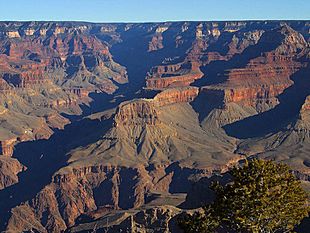Tapeats Sandstone facts for kids
Quick facts for kids Tapeats SandstoneStratigraphic range: Early to Middle Cambrian |
|
|---|---|

Muav Limestone-(greenish, slope-forming) and Bright Angel Shale, resting on Tapeats and the Tonto Platform, inner canyon, Granite Gorge (the two units are easily seen below the red-stained Redwall Limestone) (550 ft thick)
|
|
| Type | Geological formation |
| Unit of | Tonto Group |
| Underlies | Bright Angel Shale |
| Overlies | Vishnu Basement Rocks, Unkar Group, Nankoweap Formation, Chuar Group, and Sixtymile Formation |
| Thickness | 230 feet (70 m) |
| Lithology | |
| Primary | sandstone and conglomerate |
| Other | conglomeratic sandstone |
| Location | |
| Region | northern Arizona (Grand Canyon), central Arizona, southeast California, southern Nevada, and southeast Utah |
| Country | United States of America |
| Type section | |
| Named for | Tapeats Creek |
| Named by | Noble (1914) |
The Tapeats Sandstone is a very strong, flat layer of rock found in places like the Grand Canyon in Arizona. It's part of a bigger group of rocks called the Tonto Group. This rock layer can be up to about 70 meters (230 feet) thick.
The Tapeats Sandstone is special because it sits right on top of something called the Great Unconformity. This is a huge gap in Earth's rock record, like a missing chapter in a very old book! It represents about a billion years of time where no new rocks were laid down, or old ones were worn away.
Contents
What is the Tapeats Sandstone?
The Tapeats Sandstone is the lowest layer of the Tonto Group. It's made mostly of sandstone, which is rock formed from sand, and some conglomerate, which is rock made of pebbles and larger pieces stuck together.
This rock layer is very hard and doesn't wear away easily. Because it's so strong, it forms a wide, flat area called the Tonto Platform in the Grand Canyon. This platform is found around the Colorado River and its smaller streams.
How does the Tapeats Sandstone shape the Grand Canyon?
The Tapeats Sandstone creates the flat Tonto Platform. Above it, you'll find the Bright Angel Shale, which is a softer, greenish rock that forms gentle slopes. Above that are the low cliffs of the Muav Limestone.
The Tonto Platform, made partly of the Tapeats Sandstone, follows the winding path of the Colorado River. It looks a bit like the branches of a tree when seen from above.
How was the Tapeats Sandstone formed?
The Tapeats Sandstone was formed a very long time ago, during the Cambrian Period. It was laid down by an ancient ocean that slowly spread across the land. This process is called a marine transgression.
Imagine the ocean slowly moving inland. First, it would deposit sand and pebbles (which became the Tapeats Sandstone). As the water got deeper, finer mud would settle (forming the Bright Angel Shale). Finally, in the deepest parts, sea creatures and minerals would form limestone (like the Muav Limestone).
What is the Great Unconformity?
The Tapeats Sandstone sits directly on top of much older rocks, called the Vishnu Basement Rocks. There's a huge time gap between them, known as the Great Unconformity. This gap represents about 1 billion years!
It's like a missing chunk of time where rocks were either eroded away or simply not formed. In some places, the older rocks below the Tapeats are also tilted at an angle, while the Tapeats layer is flat. This is called an angular unconformity.
Exploring the Tonto Platform
The flat Tonto Platform is a great place for hiking in the Grand Canyon. Trails like the Tonto Trail run along parts of the Tapeats Sandstone. These trails connect the South Rim to the North Rim of the canyon.
Layers of the Tonto Group
The Tonto Group is made of three main rock layers, stacked on top of each other:
- 3--Muav Limestone (the top layer)
- 2--Bright Angel Shale (the middle layer)
- 1--Tapeats Sandstone (the bottom layer, where the ocean first moved in)
Images for kids
-
View of Tonto Group, in descending order: Muav Limestone, Bright Angel Shale, and Tapeats Sandstone, overlying the Great Unconformity cut into Vishnu Basement Rocks in Granite Gorge region.
-
view opposite Lipan Point, (at Desert View (Grand Canyon), East Rim), showing the banded Nankoweap Formation, (horizontal Tapeats at left, extending at base of prominence, in two fingers of rock)






